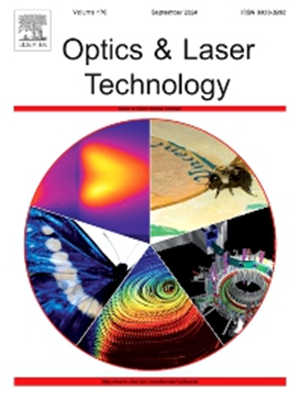Silicon photonic polarization beam splitter assisted by polarization-Selective metamaterials with 600 nm bandwidth
IF 4.6
2区 物理与天体物理
Q1 OPTICS
引用次数: 0
Abstract
Silicon photonic polarization beam splitter (PBS) is a crucial component for on-chip polarization management. PBSs typically function based on wavelength-dependent mechanisms such as evanescent coupling and modal interference. As a result, constructing a PBS with a broad bandwidth, low insertion loss, and high extinction ratio remains a significant challenge. This paper presents a novel method for achieving a PBS that is almost independent of the wavelength, which involves engineering the modal birefringence of subwavelength grating waveguides and utilizing reciprocal mode transitions. An input taper is embedded in polarization-selective metamaterials (PSMs), which are made up of two sets of subwavelength gratings arranged in different directions. As the width of the input taper decreases, the waveguide mode is no longer supported and transits into a single-mode-like (SML) component guided in the SWG waveguide. By exploiting the principle that a mode will preferentially evolve into the mode with the closest effective refractive index, polarization beam splitting is achieved during the transition of waveguide modes into SML components guided in SWGs with different arrangement directions. Results show that the proposed PBS achieves a high extinction ratio of more than 23 dB throughout a bandwidth of 600 nm (1.2–1.8 μm) for both polarizations. For TE/TM polarization, the bandwidth to achieve an insertion loss of lower than 0.41/1 dB is as large as 600 nm (1.2–1.8 μm)/530 nm (1.23–1.76 μm). As far as we know, this is the PBS with the most superior broadband performance proposed till now.
带宽为 600 纳米的偏振选择性超材料辅助硅光子偏振分束器
硅光子偏振分束器(PBS)是片上偏振管理的关键部件。偏振分束器通常基于波长相关机制(如蒸发耦合和模态干涉)发挥作用。因此,构建具有宽带宽、低插入损耗和高消光比的 PBS 仍然是一项重大挑战。本文提出了一种实现几乎不受波长影响的 PBS 的新方法,其中包括对亚波长光栅波导的模态双折射进行工程设计,并利用往复模态转换。在偏振选择超材料(PSM)中嵌入一个输入锥,PSM 由两组沿不同方向排列的亚波长光栅组成。随着输入锥的宽度减小,波导模式不再受到支持,而是转变为在 SWG 波导中引导的单模(SML)成分。利用模式会优先演化为有效折射率最接近的模式这一原理,在波导模式过渡到在不同排列方向的 SWG 中引导的 SML 分量的过程中实现了偏振分束。结果表明,所提出的 PBS 在 600 nm(1.2-1.8 μm)的带宽范围内,对两种极化都能实现超过 23 dB 的高消光比。对于 TE/TM 极化,实现低于 0.41/1 dB 插入损耗的带宽高达 600 nm(1.2-1.8 μm)/530 nm(1.23-1.76 μm)。据我们所知,这是迄今为止提出的宽带性能最优越的 PBS。
本文章由计算机程序翻译,如有差异,请以英文原文为准。
求助全文
约1分钟内获得全文
求助全文
来源期刊
CiteScore
8.50
自引率
10.00%
发文量
1060
审稿时长
3.4 months
期刊介绍:
Optics & Laser Technology aims to provide a vehicle for the publication of a broad range of high quality research and review papers in those fields of scientific and engineering research appertaining to the development and application of the technology of optics and lasers. Papers describing original work in these areas are submitted to rigorous refereeing prior to acceptance for publication.
The scope of Optics & Laser Technology encompasses, but is not restricted to, the following areas:
•development in all types of lasers
•developments in optoelectronic devices and photonics
•developments in new photonics and optical concepts
•developments in conventional optics, optical instruments and components
•techniques of optical metrology, including interferometry and optical fibre sensors
•LIDAR and other non-contact optical measurement techniques, including optical methods in heat and fluid flow
•applications of lasers to materials processing, optical NDT display (including holography) and optical communication
•research and development in the field of laser safety including studies of hazards resulting from the applications of lasers (laser safety, hazards of laser fume)
•developments in optical computing and optical information processing
•developments in new optical materials
•developments in new optical characterization methods and techniques
•developments in quantum optics
•developments in light assisted micro and nanofabrication methods and techniques
•developments in nanophotonics and biophotonics
•developments in imaging processing and systems

 求助内容:
求助内容: 应助结果提醒方式:
应助结果提醒方式:


